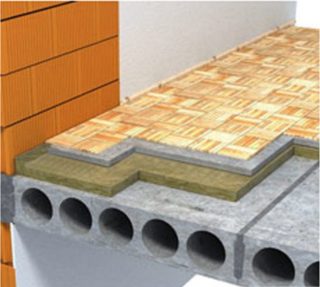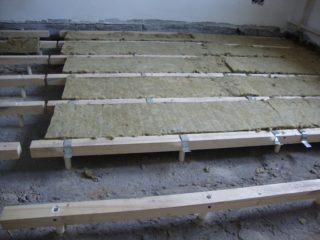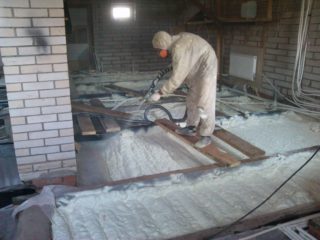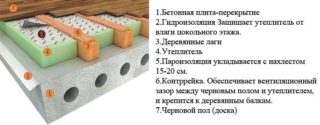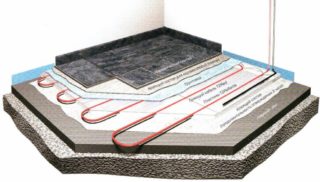Equipping the floor in the room is one of the conditions for a comfortable stay. Warming can be carried out in several ways, each of which has its positive and negative sides. It is important to choose the right insulation that will provide the optimal microclimate of the room in the most severe frosts.
How to prepare a concrete base for insulation
The old cladding is dismantled, the rough covering up to the concrete slab. The concrete flooring is carefully inspected for cracks, chips, potholes. If there are defects, they are cleaned of debris, expanding with a perforator, grinder, along the way, protruding reinforcement, sagging is removed so that the concrete flooring is even. The prepared concrete rough flooring is filled with mortar and leveled.
To obtain a concrete, durable floor with increased adhesion, it is treated with a special impregnation.
Before carrying out the insulation, it is necessary to send the concrete flooring with a film or a waterproofing membrane. Additionally, the walls are protected with waterproofing by running a film on them to a height of about 15-20 cm. After the completion of waterproofing, you can lay insulation, carry out further cladding.
Materials for thermal insulation
How to equip the room, what material to choose? First of all, they pay attention to the following indicators:
- Density, structure - the more porous the hollow material, the lower its density;
- Thermal conductivity - the higher the indicator, the worse the hollow insulation retains heat;
- Moisture permeability - is the hollow insulation capable of absorbing moisture from other coatings, the environment. To keep the room warm, it is desirable that the coefficient be as low as possible;
- Strength - determines whether a hollow insulation is capable of withstanding loads and deformation. To keep the concrete floor warm, it is worth choosing a high-strength material;
- Durability is an indicator by which it is determined whether a hollow insulation is capable of maintaining its quality during long-term operation;
- Moisture resistance - it is desirable that it be as high as possible;
- Environmental friendliness is an important indicator that ensures the comfort of living. Hollow material should not be poisonous, release toxins when burned.
Mineral, basalt or fiberglass wool
Minvata happens:
- Slag, with the addition of blast furnace slag. Possesses high thermal conductivity, but is unstable to vibration, moisture, decomposes with acid release;
- Basalt - hollow insulation with the addition of dolomite, limestone, produced in different densities. It is resistant to moisture, noise, vibration, high temperatures. Now on sale there is cotton wool on a substrate of foil, glass threads, stitched with fiberglass or wire. It is characterized by increased strength, withstands strong pressure, compression;
- Fiber glass wool is a cheap hollow material with low thermal conductivity. It possesses high noise and vibration isolation, compresses well, but deforms under load and pressure.
Plates of polystyrene, polystyrene
A type of foam is extruded polystyrene, in fact, an analogue of foam, but with improved properties. The hollow material is denser in structure and highly resistant to deformation.
Polyurethane foam, penoizol
The only drawback of polyurethane foam, penoizol is the high cost of technology, because spraying requires special equipment.
Insulation technologies
Layered cake
On the concrete floor, covered with moisture protection, a hollow crate made of wooden bars is installed. Typically, standard bars with a cross section of 5050 mm are used. For maximum protection against moisture when installing a hollow sheathing, strips of roofing material are placed under them.
Logs are mounted on the bars - slats or thick boards of wood. Each of them is covered with a special impregnation that protects against fire, fungus, mold. The thickness of the lag bars should be slightly larger than the width of the thermal insulation. It is important that after installation, the hollow insulation does not protrude above the log level.
The logs must be leveled using a level, plastic or wooden wedges. The structure is fixed on the deck by through drilling, hammering in anchors.
Then it is necessary to lay the insulation, mount the subfloor.
The selected thermal insulation material is placed in the voids between the logs on the waterproofing. Having laid the insulation, a layer of a vapor barrier membrane is lined on top. This is especially important if a material that quickly absorbs moisture is selected for the insulation.
On a layer of vapor barrier, a rough floor is attached to the logs. Particleboard, thick plywood, OSB, unedged board are ideal for this.
When the concrete flooring, the insulation is over, proceed to the final finishing.
If it is decided to sheathe a concrete floor with tiles, it is worth mounting a base on which a layer of plywood is laid, then a subfloor made of boards.
Concrete "warm floor"
It is a thin mesh mat with a heating cable with a cross-section of about 2.8 mm. The installation process consists in the fact that they are laid on a layer of concrete, securely fixed. Thermal insulation using this technology is universal, suitable for installation under laminate, linoleum, tiles. If electric heating mats are placed under linoleum, laminate, carpet, it is not necessary to fill in a thick layer of screed, 3-4 cm is enough. Electric heating mats are not placed in places where plumbing and furniture will subsequently be installed. When installing cables and wires, it is worth retreating from the walls by 5-7 cm. Also, communications should not be laid near heating sources.
Water... It is installed in private houses, multi-storey buildings on the ground floors. If the system leaks after being installed on the upper floors, there is a possibility of flooding the neighbors below. First, waterproofing, insulation of the base is carried out, for which polyurethane foam, foam plates or penofol are used. The material for insulation must be placed at a distance of 5 mm from the wall, otherwise it may deform.For laying, you will need metal-plastic or polypropylene pipes, which are laid out on a layer of insulation, fastened with special brackets, clips or brackets.
Infrared... The floor is a two-layer film 0.5 mm thick with heating carbon elements. It is attractive because, unlike other systems, it allows you to keep the configuration and the height of the room unchanged. This is the most energy-saving insulation option, which saves up to 60% of electricity. The foil cover with heating elements can be installed vertically, horizontally, obliquely by "dry mounting". Laying is simple: the strips of film are spread without taking into account the areas where the furniture will stand. After that, you can immediately cover the flooring layer without prior cement screed. After that, the ends of the supply and return pipelines are removed, connected to the collector, at the very end - to the water supply. Then it is necessary to pour the concrete layer of the screed, filling it with water before pouring the pipe. When the work is over, it is worth letting the surface dry, after which you can lay the flooring, use the heating.
Which heating option to choose depends on the characteristics of the room, the financial capabilities of the owner of the house. It is important to carry out the work with high quality, according to technology. If you have the tools, some experience in this matter, you can carry out the work yourself. Otherwise, you should trust the professionals, otherwise the rework will be very expensive.

